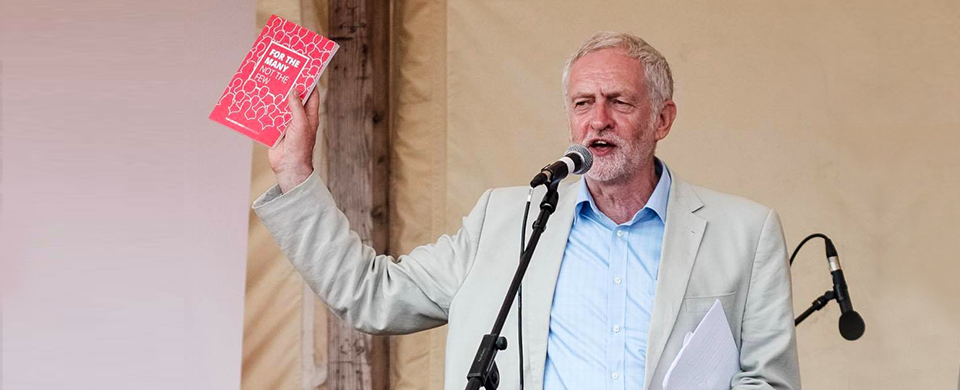A great campaign shone a light on the star of the show – an equally great manifesto
Shortly after the General Election, Theresa May appointed a senior BBC journalist as her communications chief – but perhaps she’d do better employing a Premier League manager.
Football bosses are masters at managing expectations. None of them would go into a game predicting an easy victory. But that, in effect, is what May did – and she will probably pay for it with her own premier title.
The perception that Labour ‘won’ the election arises from the way the Tories had framed it as being a certain landslide for them, with the only issue being how big it would be.
In the end, of course, they didn’t get a majority at all as Jeremy Corbyn led Labour to its best vote since 1997 and the biggest increase in the Labour vote since 1945.
So how did we surge from 24% in the polls to a 41% actual share of the vote in just seven weeks?
In a recent Guardian interview, Emily Thornberry, the Shadow Foreign Secretary, gave the credit to our policies. “I love Jeremy, but the star of the show was the manifesto,” she said.
And, in one sense, she’s absolutely right: there’s no doubt the manifesto was outstanding and proved inspirational as the campaign progressed. But a great manifesto cannot communicate itself. So how did we do that so successfully in such a short space of time?
In my view, there was no single magic ingredient. Rather, there were five major factors that we managed to combine rapidly into a highly effective campaign, despite starting with a much smaller budget than the Tories.
The first was that Jeremy is a great message carrier. This wasn’t obvious to the Tories because of his low personal ratings prior to the election. They attacked him as if he was a liability to Labour, but we were confident his warmth and wisdom would shine through once he got the obligatory fairer hearing on broadcast media and spoke at ever bigger events in an atmosphere of heightened interest in politics.
The second was that we had boots on the ground. With 500,000 plus members, Labour had more than three times as many people to call on as the Tories. From the day the election was called, when Jeremy visited the Tory held marginal Croydon Central, we saw huge numbers turning out to campaign with him and other shadow cabinet members. And as the campaign grew, so did the flow of cash to finance it: online fund-raising alone raised more than £4m in donations averaging £19. With a similar sum coming from union affiliates, we began to match the money the Tories had from wealthy donors.
The third factor was a hugely successful voter registration campaign, which we launched on our ‘flying start’ weekend on April 29-30 with the support of a host of celebrities. In just over three weeks, more than two million people visited the Electoral Commission’s website, leading to an unprecedented number of successful registrations by young voters.
Social media, the main platform for the voter registration campaign, was the fourth key ingredient. Jeremy’s personal social media presence was huge at the outset. By the end of the campaign, his Twitter following had grown 32% to 1.2m and the likes for his Facebook had increased 31% to £1.21m. His video posts on both channels were watched by millions, with one attracting 8.35 million views. Alongside this, Labour’s Facebook page saw likes reaching nearly a million (up 44%), and the party’s Twitter following rose to nearly half a million (up 24%). With donations flooding in, we were able to complement this extraordinary organic presence with smart tactical use of paid-for digital advertising to reach demographic groups under-represented in our organic following and to reinforce calls to action. This included an online Get Out The Vote campaign that saw 1.24 million people visit our Polling Station Finder.
The fifth and final factor was a strategic decision tackle tough issues pro-actively. This goes against conventional wisdom, but we thought perceived weaknesses on Europe, Jeremy’s leadership and national security could actually be strengths – if we could reframe them. We therefore allocated a party political broadcast to Brexit, scheduled set-piece speeches to allow Jeremy to outline fully his approach to leadership and security, and built these themes into our messaging.
In all of this, we were aided by a wooden performance from Theresa May and a disastrous Tory manifesto. Under pressure, the Tories had no plan B. As our support grew, they simply escalated their smear campaign and spent millions on scurrilous attack ads. But this only deepened the perception – especially among young people – that they had nothing positive to offer. Suddenly, in the final two weeks, a Corbyn-led government was seen as a real possibility.
It proved tantalisingly close. Now the fight for the policies in our manifesto continues.
Steve Howell
A version of this article first appeared in Influence, the weekly e-magazine of the Chartered Institute for Public Relations.
Steve is also author of Over The Line, a novel telling the story of an Olympic poster girl tainted by the steroid-fuelled death of a friend.
Over The Line is available on Kindle (£1.99), Kindle Unlimited (free to subscribers) and in paperback (£7.99) via Amazon or post free via the secure PayPal facility on this website – ORDER

